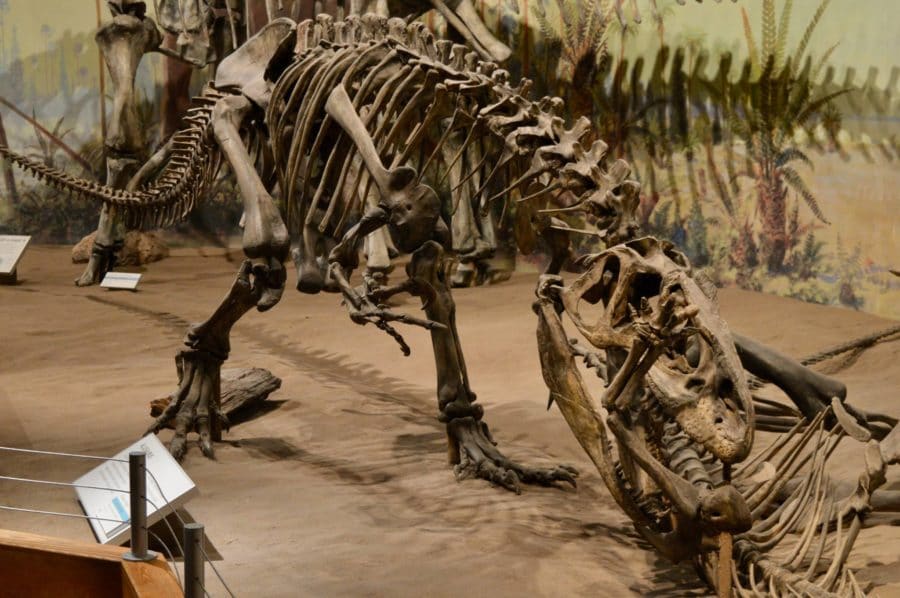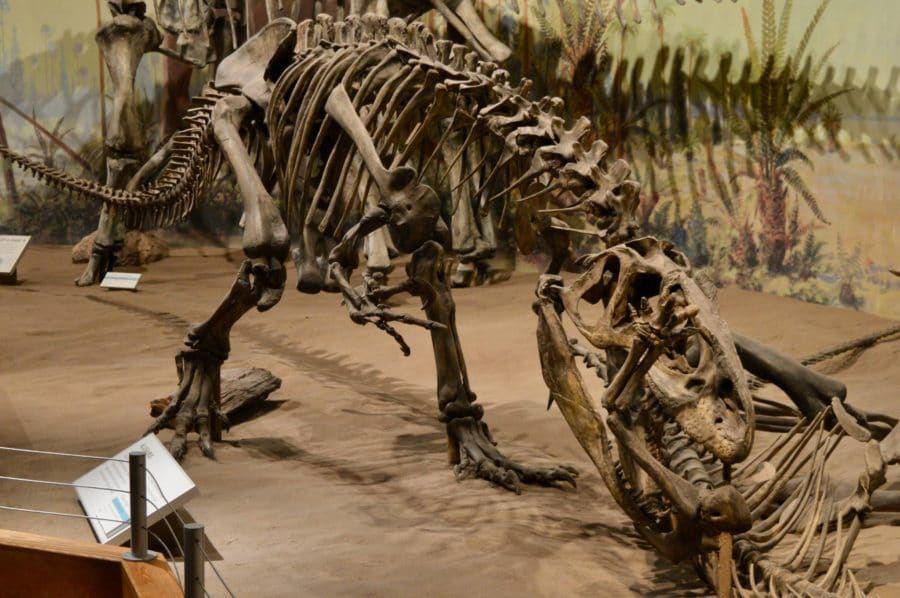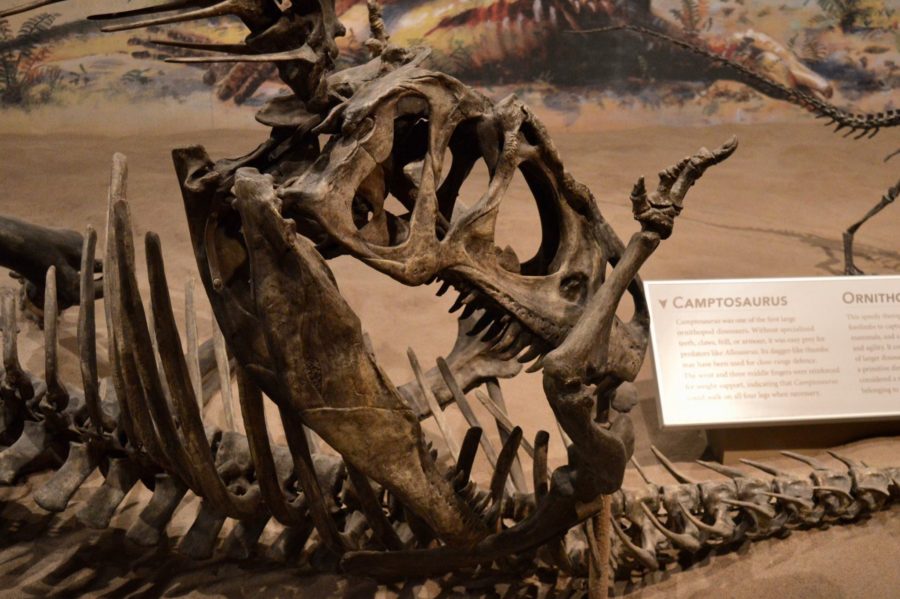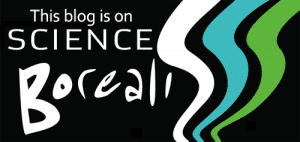
Try to imagine, if you can, a world before Tyrannosaurus was the definitive carnivorous dinosaur. There was actually a time when that was indeed the case. Dinosaurs were first defined as a group in 1842, and Tyrannosaurus wasn’t described until 1905. That’s over sixty years of scientists and the public being aware of dinosaurs, but unaware that the tyrant king of reptiles lay buried in late Cretaceous rocks in western North America.
The first dinosaur that people ever thought of as the defining ‘big nasty carnivore’ was Megalosaurus, but remains of this dinosaur have always been fragmentary, and it languished for years as a wastebasket taxon. Between this first-known fossil theropod and the discovery of T. rex, another dinosaur held the title of the Mesozoic’s top terrestrial villain, and that was Allosaurus.
Allosaurus is a fairly well-known dinosaur, maybe not top-tier in general popularity, but it can easily be found in most dinosaur picture books, documentaries like Walking with Dinosaurs, and many palaeontology museums. Most recently, it was even shown briefly in the movie Jurassic World: Fallen Kingdom. As is typical with most large theropods, though, it’s often mistaken at first glance for Tyrannosaurus by the public, and I feel as if I’ve already done Allosaurus a disservice by introducing it in terms of its cultural relation to T. rex instead of its own merits. So let’s look closer into the real Allosaurus.
This dinosaur comes from the late Jurassic Morrison Formation, a unit of rock that stretches throughout much of the western United States. The Morrison contains some of the most iconic dinosaurs of all time, such as Stegosaurus, Brontosaurus, and Diplodocus, as well as many, many more. Like so many other Morrison taxa, Allosaurus first came to light during the famous Bone Wars, but the history of its discovery goes further back and, like much of early palaeontology, is pretty complicated. The first described fossil that was likely from Allosaurus, a tail vertebra, was acquired by the godfather of American palaeontology, Joseph Leidy. This was immediately before the great dinosaur rush of the western United States, when Leidy’s successors, Edward Drinker Cope and Othniel Charles Marsh, would form their competing monopolies on American palaeontology for a while and unearth a trove of extinct reptiles.
Leidy first assigned his incomplete vertebra to the European genus Poekilopleuron (Leidy, 1870), before re-describing it under the name Antrodemus (Leidy, 1873). This vertebra was eventually found to be indistinguishable from Allosaurus (Gilmore, 1920), and the latter name was allowed to stay since the Antrodemus fossil doesn’t really have anything distinguishable about it (Madsen, 1993).
The name Allosaurus was coined in 1877 by Marsh, who was working with material from Colorado that was scarcely better than Leidy’s before him (Marsh, 1877). In his and Cope’s haste to describe as many new fossils as they could (and out-do one another), the two feuding palaeontologists ended up giving many different names to a few of the same dinosaurs. These descriptions often lacked any illustrations to help show off the fossils, and that modern palaeontologists would find them laughably brief. Marsh himself unknowingly re-described Allosaurus a few times from other material to which he gave the names Creosaurus (Marsh, 1878) and Labrosaurus (Marsh, 1879), and Cope described some Allosaurus remains he had as Epanterias (Cope, 1878). Cope wasn’t even aware that he possessed one of the most complete Allosaurus specimens ever found, which sat unprepared in boxes in his massive collection until just after his death, when the specimen was shipped to the American Museum of Natural History where it has since been on display for decades, even inspiring Charles R. Knight’s famous Allosaurus painting (Norell et al., 1995). This iconic AMNH mount, along with Knight’s artwork, are what first cemented the Allosaurus into people’s minds.

A mounted Allosaurus skeleton shown attacking the plant-eating dinosaur Camptosaurus, at the Royal Tyrrell Museum. Photo by Nicholas Carter
After the Bone Wars ended, and the West opened up for more cooperative palaeontology efforts, many more specimens of Allosaurus were collected. Perhaps the most significant of Allosaurus fossil sites is the Cleveland-Lloyd Dinosaur Quarry in Utah (Stokes, 1945). This bonebed is full of late Jurassic dinosaurs, and for some reason (which we’ll get to later), Allosaurus seems to be not only the most common predator at the site, but the most common dinosaur.
Fossil sites like Cleveland-Lloyd and many other discoveries have revealed a lot about Allosaurus, making it one of the best understood dinosaurs in the world. One particularly good specimen, famous among dino-fans worldwide, was found in Wyoming in the 90’s. Nicknamed ‘Big Al’, this Allosaurus specimen is almost totally complete, and shows an amazing variety of diseases, infections, and injuries across its skeleton (Breithhaupt, 1996). Big Al’s foot bones, in particular, show a many signs of injuries and infections, leading to extra bone growth where there shouldn’t be any. Seeing as how Big Al wasn’t fully grown when it died, it’s safe to say that old age definitely didn’t kill this dinosaur. This animal lived a hard, rough life, and was likely in considerable pain when it died. The foot pathologies in particular suggest that Big Al was probably unable to hunt, and perhaps a combination of disease and hunger brought it down. Bone pathologies from many dinosaur groups tell us that these animals often led hard, short lives, but some clearly lived harder lives than others.
One topic that’s only just now becoming clearer, though, is our understanding of the classification of Allosaurus species. Marsh’s description and material from his Allosaurus fragilis were enough to tell this creature apart from other types of Morrison Formation theropods, but not to adequately tell it apart from other allosaur-type dinosaurs. Allosaurus remains from a higher part of the Morrison, the Brushy Basin Member, get assigned to this species, which includes the Cleveland-Lloyd allosaurs (Loewen et al., 2003). But in order to really define what exactly is and isn’t Allosaurus fragilis, there’s been a petition to designate a new defining specimen, or a ‘neotype’ for this species (Paul & Carpenter, 2010).
Incomplete allosaur material similar to A. fragilis has also been found in Portugal, which in the late Jurassic was much closer to the United States than today. This Portuguese species was named Allosaurus europeaus (Mateus et al., 2006), although other’s have argued that it’s really the same thing as A. fragilis (Malafaia et al., 2007).
It’s long been recognized that a second American Allosaurus species was present in the low Salt Marsh Member of the Morrison Formation. Specimens of this second species were first found at Utah’s Dinosaur National Monument, and others seeming to be of this species have been found in Wyoming as well. It wasn’t until this year, though, that this second American Allosaurus species was formally named and described. It’s now called Allosaurus jimmadensi, and includes the Dinosaur National Monument allosaurus as well as Big Al (Chure & Loewan, 2020).
It’s not too hard to tell Allosaurus fragilis and Allosaurus jimmadensi apart when you see their skulls. Both have the characteristic Allosaurus look with their pointed horns in front of the eyes. However, the jugal, or ‘cheek bones’ of A. fragilis deflect downwards at the back of the jaw, and the snout tends to be deeper and more blunt. In A. jimmadensi, the cheek region is fairly straight and continuous with the bottom of the skull, and the snout is shallower and narrower. Perhaps this difference in skull build could reflect different feeding habits of these two species.

A close-up at of an Allosaurus skull at the Royal Tyrrell Museum. That downward-deflected cheek bone, as well as other features, show that this is Allosaurus fragilis. Photo by Nicholas Carter
By learning about the world Allosaurus inhabited, we can infer some things about its possible behaviour when it was alive. The Morrison Formation of the western United States was somewhat like an African savannah, except there was no grass, because grass (and flowering plants in general) hadn’t evolved by then. The landscape would have featured rivers lined with dense forests of conifers, cycads, ginkgoes, and tree ferns. In between were flat, open fern prairies. It was always generally warm, and the landscape was lush and green during the short wet seasons. However, long dry seasons would’ve made the Morrison quite arid much of the time. It was a tough environment for tough animals.
Allosaurus would have interacted with a variety of animals here, but how exactly it made its living is a debated subject. Its actually had to coexist alongside other large carnivores during this time, such as the smaller, horned predator Ceratosaurus and the bulkier megalosaur Torvosaurus. These other theropods had a lower build to them, and may have been comparably slower than Allosaurus. It’s been suggested that they lived in the riparian forests, preying on herbivores like ornithopods or ankylosaurus, while Allosaurus mostly dwelled out on the fern prairies (Bakker & Bir, 2004). While it might seem unlikely that at least three genera of large dinosaurian predators could coexist, it’s not as crazy as you might think. Looking at modern mammals alone, bears, wild dogs, and big cats share much of North America today, and several big cats share Africa with hyenas and wild dogs.
The range of possible prey for Allosaurus spread out over the millions of year of its reign is a real ‘greatest hits’ list of late Jurassic dinosaurs. Options for herbivore prey alone included bipedal ornithopods like the deer-sized Dryosaurus or the cow-sized Camptosaurus, and armored browsers like Gargoyleosaurus, Hesperosaurus, or Stegosaurus. There was also an amazing diversity of giant plant-eating sauropods throughout the physical and temporal space of the Morrison like Haplocanthosaurus, Brontosaurus, Apatosaurus, Diplodocus, Barosaurus, Camarasaurus, and Brachiosaurus.
This gave Allosaurus a lot of options, but bringing down these herbivores would have required different strategies. Small and mid-sized ornithopods were probably not hard to kill, but with their nimble build, may have taken some effort to catch. Armored dinosaurs like Stegosaurus seem like they would have been hazardous, what with those defensive bony spikes, and there’s evidence of Stegosaurus and Allosaurus having a predator-prey relationship in which each sometimes got the better of the other (Carpenter et al, 2005). The biggest question, though, has to be whether or not Allosaurus preyed on the variety of sauropods it lived alongside, and if so, how it managed it.
At over 9 meters long and equal in weight to a mid-sized rhinoceros, Allosaurus was no slouch when it comes to large predators. Granted, it doesn’t seem to have reached the gigantic proportions that its carnosaurian relatives would get to in the first half of the Cretaceous, but it was one of the larger predators in its ecosystem. But how does a dinosaur this size bring down a sauropod equal to several elephants in size? Pack hunting might have been useful to Allosaurus, and it’s certainly been suggested in the past that it hunted in groups to bring down giant-sized game (Farlow, 1976) (Bakker, 1997). However, as often as the idea of pack-hunting theropods has been brought up, many authors have found the idea hard to prove and fairly unlikely (Roach & Brinkman, 2007). Readers who remember the Allosaurus-dominated Cleavland-Lloyd Dinosaur Quarry might now be saying that this site represents great evidence for social behavior in Allosaurus. This interpretation, however, isn’t exactly supported by science. The CLDQ seems to have been, in those days, an ephemeral pond around which large herbivores tended to die during times of intense drought, which would then attract lone Allosaurus’ to the site to scavenge (Gates, 2005). The idea is that, during a time of extremely drought, many Allosaurus individuals became attracted to this watering hole over time to feed off dead and dying herbivores, but after this food source ran dry, began to die at the site as well, perhaps even turning on each other.
So if Allosaurus was potentially hunting sauropods on its own during less extreme times, it must have had some clever ways of doing so. Robert Bakker observed some analogous features between Allosaurus and saber-toothed cats, like reduced jaw muscles at the expense of powerful neck muscles and an increased gape, and suggested that this dinosaur used its upper tooth row like a saw or hatchet, driving it into prey with its powerful neck (Bakker, 1998). Taking off from this, other authors have found that, while Allosaurus had a relatively weak bite, it could withstand a lot of pressure along the edges of the jaws, which is may have used to hack and slice away at large herbivores (Rayfield et al., 2001). Other palaeontologists have argued against this, noting that no living animal uses its head in this way, and that Allosaurus’ skull was likely quite strong simply to withstand the force of struggling prey (Frazzetta & Kardong, 2002).
It seems more likely that, when Allosaurus attacked sauropod-sized prey, it was biting directly at convex body parts with a smaller surface area to really maximize the sides of its jaws, aided by its enormous gape (Anton et al., 2003). It also had fairly powerful front limbs capable of holding on to struggling prey, helped out by its meat hook-shaped claws no doubt (Carpenter, 2002). One study has also shown that Allosaurus likely would have de-fleshed its prey in a similar manner to a falcon, bracing its kill with its claws and pulling straight back on each bite with its powerful neck (Snively et al., 2013). To see more thoughts on Allosaurus’ hunting and killing strategies, I suggest going here.
All in all, if Allosaurus did go after live sauropods, we can image it likely running up to its chosen target and, instead of hacking away open-mouthed at the animal, deliberately biting with the whole mouth or perhaps the sides of the jaws in areas like the belly, neck, or limbs. Perhaps Allosaurus even held onto fleeing sauropods with its front limbs, delivering further bites until the animal died from blood loss and exhaustion. Then, when feeding, it consumed its kill like a giant predatory bird. This method drastically differs from the carnivore that Allosaurus is so often compared to, Tyrannosaurus. T. rex was, by comparison, kind of a brute, whose strategy was to bite down hard straight into the prey, crushing bones and organs as it went, then shaking its head from side to side each bite to tear off a hunk, much like a modern crocodile does.
As you can see from this pretty lengthy article (including a very lengthy references section), we know a fair deal about Allosaurus compared to many other carnivores. It’s a dinosaur that’s been with us for a long time, one of the first to be synonymous with the idea of big carnivorous theropods in our minds. Allosaurus lived a hard life in a hard environment, but still managed to thrive in this world for millions of years. It might not have been the biggest carnivore in history, but Allosaurus was definitely one of the baddest.
By Nicholas Carter
References
Anton, Mauricio & Sánchez, Israel & Salesa, Manuel & Turner, A.. (2003). The muscle-powered bite of Allosaurus (Dinosauria; Theropoda): An interpretation of cranio-dental morphology. Estudios Geologicos. 59. 10.3989/egeol.03595-6106.
Bakker, Robert T. (1997). “Raptor Family values: Allosaur parents brought giant carcasses into their lair to feed their young”. In Wolberg, Donald L.; Sump, Edmund; Rosenberg, Gary D. (eds.). Dinofest International, Proceedings of a Symposium Held at Arizona State University. Philadelphia: Academy of Natural Sciences. pp. 51–63.
Bakker, Robert T. (1998). “Brontosaur killers: Late Jurassic allosaurids as sabre-tooth cat analogues”. Gaia. 15: 145–158.
Bakker, Robert T.; Bir, Gary (2004). “Dinosaur crime scene investigations: theropod behavior at Como Bluff, Wyoming, and the evolution of birdness”. In Currie, Philip J.; Koppelhus, Eva B.; Shugar, Martin A.; Wright, Joanna L. (eds.). Feathered Dragons: Studies on the Transition from Dinosaurs to Birds. Bloomington and Indianapolis: Indiana University Press. pp. 301–342.
Breithaupt, Brent (1996). “The discovery of a nearly complete Allosaurus from the Jurassic Morrison Formation, eastern Bighorn Basin, Wyoming”. In Brown, C.E.; Kirkwood, S.C.; Miller, T.S. (eds.). Forty-Seventh Annual Field Conference Guidebook. Casper, Wyoming: Wyoming Geological Association. pp. 309–313.
Carpenter, Kenneth (2002). “Forelimb biomechanics of nonavian theropod dinosaurs in predation”. Senckenbergiana Lethaea. 82 (1): 59–76.
Carpenter, Kenneth; Sanders, Frank; McWhinney, Lorrie A.; Wood, Lowell (2005). “Evidence for predator-prey relationships: Examples for Allosaurus and Stegosaurus”. In
Carpenter, Kenneth (ed.). The Carnivorous Dinosaurs. Bloomington and Indianapolis: Indiana University Press. pp. 325–350.
Chure, D.J.; Loewen, M.A. (2020). “Cranial anatomy of Allosaurus jimmadseni, a new species from the lower part of the Morrison Formation (Upper Jurassic) of Western North America”. PeerJ. 8: e7803.
Cope, Edward Drinker (1878). “A new opisthocoelous dinosaur”. American Naturalist. 12 (6): 406–408.
Farlow, James O. (1976). “Speculations about the diet and foraging behavior of large carnivorous dinosaurs”. American Midland Naturalist. 95 (1): 186–191
Frazzetta, T. H.; Kardong, K. V. (2002). “Prey attack by a large theropod dinosaur”. Nature. 416 (6879): 387–388.
Gates, Terry. (2005). The Late Jurassic Cleveland-Lloyd Dinosaur Quarry as a Drought-Induced Assemblage. Palaios. 20. 363-375. 10.2110/palo.2003.p03-22.
Gilmore, Charles W. (1920). “Osteology of the carnivorous dinosauria in the United States National Museum, with special reference to the genera Antrodemus (Allosaurus) and Ceratosaurus”. Bulletin of the United States National Museum. 110 (110): 1–159.
Leidy, Joseph (1870). “Remarks on Poicilopleuron valens, Clidastes intermedius, Leiodon proriger, Baptemys wyomingensis, and Emys stevensonianus”. Proceedings of the Academy of Natural Sciences of Philadelphia. 22: 3–4.
Leidy, Joseph (1873). “Contribution to the extinct vertebrate fauna of the western territories”. Report of the U.S. Geological Survey of the Territories I: 14–358.
Loewen, Mark A.; Sampson, Scott D.; Carrano, Matthew T.; Chure, Daniel J. (2003). “Morphology, taxonomy, and stratigraphy of Allosaurus from the Upper Jurassic Morrison Formation”. Journal of Vertebrate Paleontology. 23 (3): 72A.
Madsen, James H., Jr. (1993) [1976]. Allosaurus fragilis: A Revised Osteology. Utah Geological Survey Bulletin 109 (2nd ed.). Salt Lake City: Utah Geological Survey.
Malafaia, Elisabete; Dantas, Pedro; Ortega, Francisco; Escaso, Fernando (2007). “Nuevos restos de Allosaurus fragilis (Theropoda: Carnosauria) del yacimiento de Andrés (Jurásico Superior; centro-oeste de Portugal)” [New remains of Allosaurus fragilis (Theropoda: Carnosauria) of the Andrés deposit (Upper Jurassic; central-west Portugal)] (PDF). Cantera Paleontológica (in Spanish and English): 255–271.
Marsh, Othniel Charles (1877). “Notice of new dinosaurian reptiles from the Jurassic formation”. American Journal of Science and Arts. 14 (84): 514–516.
Marsh, Othniel Charles (1878). “Notice of new dinosaurian reptiles”. American Journal of Science and Arts. 15 (87): 241–244.
Marsh, Othniel Charles (1879). “Principal characters of American Jurassic dinosaurs. Part II”. American Journal of Science. Series 3. 17 (97): 86–92
Mateus, Octávio; Walen, Aart; Antunes, Miguel Telles (2006). “The large theropod fauna of the Lourinha Formation (Portugal) and its similarity to that of the Morrison Formation, with a description of a new species of Allosaurus”. In Foster, John R.; Lucas, Spencer G. (eds.). Paleontology and Geology of the Upper Jurassic Morrison Formation. New Mexico Museum of Natural History and Science Bulletin, 36. Albuquerque, New Mexico: New Mexico Museum of Natural History and Science. pp. 123–129
Norell, Mark A.; Gaffney, Eric S.; Dingus, Lowell (1995). Discovering Dinosaurs in the American Museum of Natural History. New York: Knopf. pp. 112–113
Paul, Gregory S.; Carpenter, Kenneth (2010). “Allosaurus Marsh, 1877 (Dinosauria, Theropoda): proposed conservation of usage by designation of a neotype for its type species Allosaurus fragilis Marsh, 1877”. Bulletin of Zoological Nomenclature. 67 (1): 53–56.
Rayfield, Emily J.; Norman, DB; Horner, CC; Horner, JR; Smith, PM; Thomason, JJ; Upchurch, P (2001). “Cranial design and function in a large theropod dinosaur”. Nature. 409 (6823): 1033–1037.
Roach, Brian T.; Brinkman, Daniel L. (2007). “A reevaluation of cooperative pack hunting and gregariousness in Deinonychus antirrhopus and other nonavian theropod dinosaurs”. Bulletin of the Peabody Museum of Natural History. 48 (1): 103–138.
Snively, Eric.; Cotton, John R.; Ridgely, Ryan; Witmer, Lawrence M. (2013). “Multibody dynamics model of head and neck function in Allosaurus (Dinosauria, Theropoda)”. Palaeontologia Electronica. 16 (2). doi:10.26879/338
Stokes, William L. (1945). “A new quarry for Jurassic dinosaurs”. Science. 101 (2614): 115–117.
